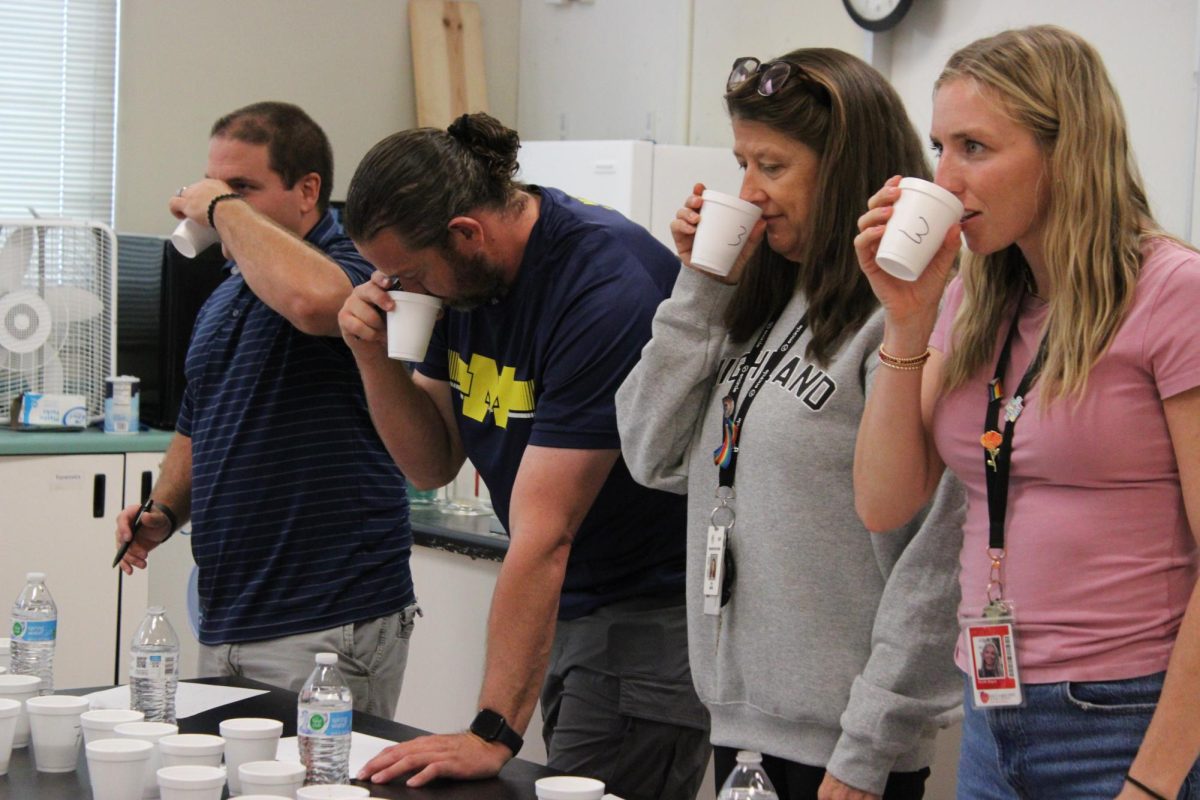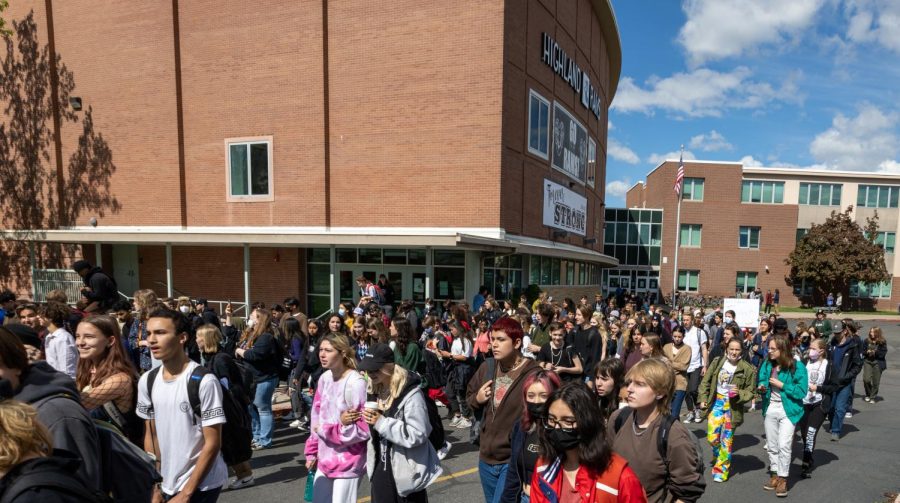The Politics of School
It’s Harder Than Ever to Avoid Politics in School
Hundreds of Highland students walk off school grounds on May 12th, 2022 to continue their protest of the Supreme Court’s draft to overturn Roe v. Wade.
October 19, 2022
The decades of the counterculture movement are remembered by many as the era of good music, flower power, and protests.
As the Vietnam war raged across the globe, thousands of Americans carried out protests reflecting the tumultuous atmosphere of the time: some peaceful, some not.
Many of these protests took place on college campuses and at other educational institutions. Some are only remembered by those who attended while others, like the protest on May 4th, 1970 now known by many as the Kent State massacre, live on in infamy. Famous or not, they remain a part of history.
History, no matter how many people know it, always seems to repeat itself. Roughly 50 years after student-led protest became an explosive new political anti-war tool, the country is seeing another rise in student action.
Recently schools have begun to see an uptick in political action by students, whether it’s in the form of a message on a sticker or pin, the formation of a new club, or even protests organized and carried out at schools.
Now, as with many topics these days, the role of politics in schools has become a political issue itself. Some people believe that high schools should be strictly for non-partisan education while others argue that allowing students to openly express political beliefs is important to prepare young adults for the real world.
Highland teacher Jennifer Jacobson is of the latter opinion.
“This is when we have young people start to make decisions determining the kind of adults they’re going to be,” Jacobson said.
According to Jacobson, ages 14-25 are especially important for young adults when it comes to forming their own identity. It’s in these 11 years that students start to take interest in causes and politics. It’s also when students start discovering the things they care about.
With high school years being a time for many to figure out what their political beliefs and actions will be, Jacobson worries that preventing students from being able to take political action in schools will push them to take that same action in unsafe places.
“Schools have always been a safe place for ideas, […] and it’s a place where they’re learning about new ideas, so it seems like a natural place for [student action] to happen,” Jacobson said.
Jacobson says that if there is continued censorship of students on campuses, as has been seen at schools across the country, then student rallies or other political events may no longer be seen as a safe space for students.
“I feel like last year students felt like they were safe in getting up and speaking their minds, but in a greater political rally that’s not on campus there might be the risk of not feeling safe. Or having people come in who aren’t supportive of the cause and causing problems,” Jacobson said.
Despite the risks of joining a political event or movement that takes place away from the safety of campus, many students do so every year. In the past, many Highland students have participated in rallies, campaigns, and protests.
Most recently, several Highland students participated in a die-in at the Great Salt Lake. The die-in, a protest where the participants staged a mass “dying” to identify a threat to the public, aimed to demand that state leaders take action to protect the disappearing landmark.
“It was really for the youth, and just to kind of bring attention to how younger people really do care, and how the younger generation is going to be the next generation of voters, and how we are going to be making an impact,” Sheyda Allen, a junior who helped plan the die-in through Utah Youth Environmental Solutions, or UYES, said.
UYES is an organization that aims to empower youth around the state to take action on various Utah-based climate issues through legislation, education, and action. Their primary goal, apart from making an impact on environmental issues, is to just get the younger generations involved.
Junior Niels Matsen, who also helped plan and execute the die-in alongside Allen, says that the participation of schools in the event would have helped UYES and the youth participants to meet that goal.
“I think that schools can be a really good way to spread the word about things like that to young people,” Matsen said. “Had schools been directly involved in the die-in and publicized that, we probably could have had a much larger turn out in terms of youth and people under 18, because that was sort of the main point of the die-in was to show how much the young people care about the Great Salt Lake.”
Similar support for using schools to publicize and diversify movements was voiced by Allen.
“I think that schools are just a really good way to be able to reach a lot of people, because outside of school you don’t really have that opportunity to have access to hundreds of people usually,” Allen said.
However, both agree that if schools are to be used as a tool for political outreach and action, they must be nonpartisan when it comes to allowing the display of politics.
“As long as it’s fair, and schools are allowing people with a variety of different opinions to make their voices heard through the school and it’s not just one narrative that’s being pushed by the school,” Matsen said.
Allen says that even with open dialogue in schools, there are some things for which advocacy should be disallowed.
“I definitely think that like, hate speech and that kind of thing shouldn’t be advocated for, but I think that having schools with open discussion about activism and how you can really support your cause is really beneficial to the general public,” Allen said.
Allen’s mention of how schools should limit advocacy for or use of certain topics or language touches on an important aspect of the debate over the extent to which schools should allow political advocacy by students on campus.
While political speech in most settings can be protected under the first amendment right to free speech, students can’t always rely on the same protections from their schools. The Supreme Court has ruled in the past that schools have the power to limit students’ speech when they are on school grounds or participating in school activities.
In January of 1988, the Supreme Court decision in the case of Hazelwood v. Kuhlmeier ended in one such ruling.
When the journalism students of Hazelwood East High in St Louis, MO wrote articles in which they featured their fellow students discussing experiences with teen pregnancies and the impact of divorce, the principal deleted the pages containing the articles prior to publication. The students legally challenged the principal’s actions, taking it all the way to the Supreme Court.
The final ruling stated that the principal was well within his rights to make decisions regarding what was and wasn’t appropriate to run in a school publication, even if that decision involved limiting the free speech of students. Schools reserve the right to have a final say in what students can and can’t do or say on school grounds or at school-affiliated events.
Jacobson, who wrote for her own student paper when she was in high school, says that she remembers her teacher reminding the class that they didn’t have freedom to write whatever they wanted.
“I remember our teacher saying to us (I wrote editorials), ‘You have to keep things within limits, because the school absolutely can censor your school newspaper because it’s an extension of the school,’” Jacobson said.
This limit of free speech was something Jacobson found both fascinating and infuriating as a student, but from the viewpoint of a teacher now sees why schools have that right.
Inflammatory or offensive things said by students in a school setting generally cause backlash to the school, whether or not the administration responds to the statement or action.
While there are plenty of cases over the past decades in which students have seen their speech limited by school officials, the administration at Highland has not censored any larger-scale instances of expression by students.
There have been Highland events that have caused worry about possible need for censorship. A September football game with a USA theme had Highland principal Jeremy Chatterton and other administrative staff concerned that some students might take the opportunity to wear vulgar or obscene apparel in the spirit of red, white, and blue.
The week before, Brighton High School had chosen a similar theme for a football game. Several of their students opted for clothing and flags promoting various political figures. This personal expression on part of the students was protected, however, had any students worn vulgar or obscene clothing, the faculty would have been able to censor the offending garments.
“We can’t have stuff that’s vulgar or calling someone out, but if someone wanted to have something of a specific candidate, they would have the right to do that,” Chatterton said.
While the red, white, and blue football game was not intended as or used as a political tool for any students, other student-led events involving direct political action have taken place at Highland.
Just last year, multiple walk-outs were organized and carried out by student activists on school grounds, with the administration providing the Highland campus as a safe place for rallying when they were told about the planned protest.
“Students have the right to walk out,” Chatterton said. “And we will continue to protect that right completely.”
Even though students do have the right to walk out, there will still be consequences, such as being marked tardy or absent. However, it’s these consequences that help make student walk-outs impactful.
There are limitations to the support for walk-outs and protests that the school can provide. When the second organized walk-out last spring went over the allotted 15 minutes, the rallying students had to move the protest off of school grounds to a public place.
Despite the consequences of missing part of class, many students from both Highland and SPA participated in the two walk-outs.
“What was great about last year,” Jacobson said, referring to the walk-outs, “is that we had a great cross-section of students. The administration was supportive of the students doing what they did.”
“It was invigorating to stand there and watch these 15, 16, and 17-year-olds get up on this platform and speak so passionately about things that they were concerned about,” Jacobson said. “I hope it continues; I hope students continue to find their voice.”





























